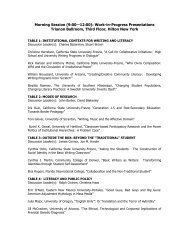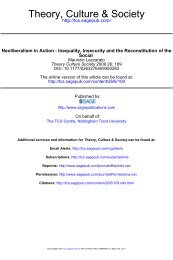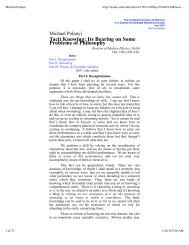PUBLIC OPINION by WALTER LIPPMANN TO FAYE LIPPMANN ...
PUBLIC OPINION by WALTER LIPPMANN TO FAYE LIPPMANN ...
PUBLIC OPINION by WALTER LIPPMANN TO FAYE LIPPMANN ...
Create successful ePaper yourself
Turn your PDF publications into a flip-book with our unique Google optimized e-Paper software.
that it seems less dangerous to fight than to keep on talking.<br />
There are certain clues which often help in detecting the false<br />
absolutism of a stereotype. In the case of the Ruritanian propaganda<br />
the principles blanketed each other so rapidly that one could readily<br />
see how the argument had been constructed. The series of<br />
contradictions showed that for each sector that stereotype was<br />
employed which would obliterate all the facts that interfered with the<br />
claim. Contradiction of this sort is often a good clue.<br />
2<br />
Inability to take account of space is another. In the spring of 1918,<br />
for example, large numbers of people, appalled <strong>by</strong> the withdrawal of<br />
Russia, demanded the "reestablishment of an Eastern Front." The war,<br />
as they had conceived it, was on two fronts, and when one of them<br />
disappeared there was an instant demand that it be recreated. The<br />
unemployed Japanese army was to man the front, substituting for the<br />
Russian. But there was one insuperable obstacle. Between Vladivostok<br />
and the eastern battleline there were five thousand miles of country,<br />
spanned <strong>by</strong> one broken down railway. Yet those five thousand miles<br />
would not stay in the minds of the enthusiasts. So overwhelming was<br />
their conviction that an eastern front was needed, and so great their<br />
confidence in the valor of the Japanese army, that, mentally, they had<br />
projected that army from Vladivostok to Poland on a magic carpet. In<br />
vain our military authorities argued that to land troops on the rim of<br />
Siberia had as little to do with reaching the Germans, as climbing<br />
from the cellar to the roof of the Woolworth building had to do with<br />
reaching the moon.<br />
The stereotype in this instance was the war on two fronts. Ever since<br />
men had begun to imagine the Great War they had conceived Germany held<br />
between France and Russia. One generation of strategists, and perhaps<br />
two, had lived with that visual image as the starting point of all<br />
their calculations. For nearly four years every battle-map they saw<br />
had deepened the impression that this was the war. When affairs took a<br />
new turn, it was not easy to see them as they were then. They were<br />
seen through the stereotype, and facts which conflicted with it, such<br />
as the distance from Japan to Poland, were incapable of coming vividly<br />
into consciousness.<br />
It is interesting to note that the American authorities dealt with the<br />
new facts more realistically than the French. In part, this was<br />
because (previous to 1914) they had no preconception of a war upon the<br />
continent; in part because the Americans, engrossed in the<br />
mobilization of their forces, had a vision of the western front which<br />
was itself a stereotype that excluded from _their_ consciousness<br />
any very vivid sense of the other theatres of war. In the spring of





